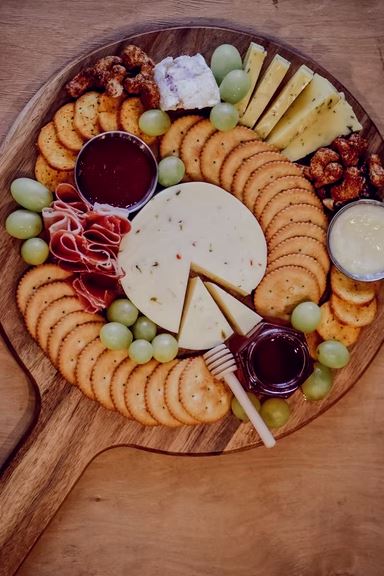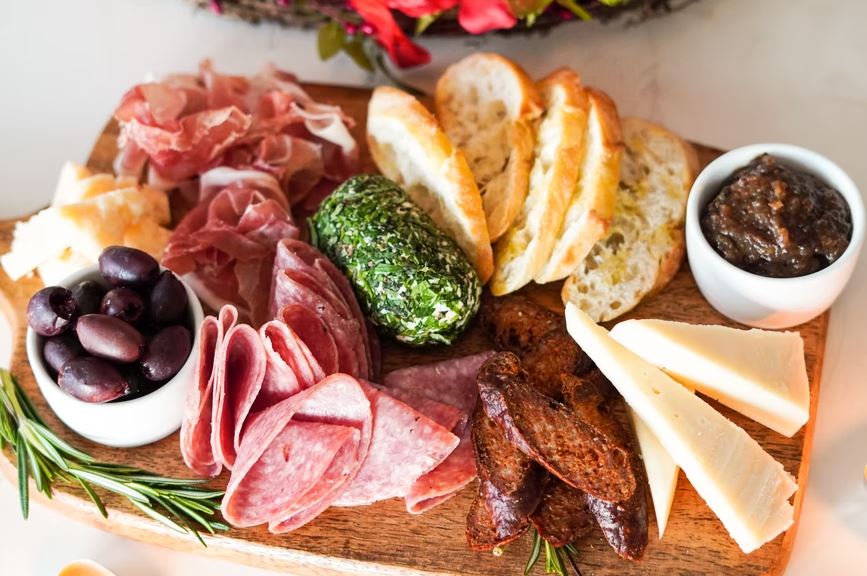If you’re not familiar with the word “charcuterie,” you may probably view it as something fancy and inaccessible. But if you’re a fan of pepperoni, sausages, and cheese, you will be a fan of charcuterie. It’s an impressive yet inexpensive party food or picnic food to serve as an appetizer.
What is Charcuterie?
The term “charcuterie” originated from the French “chair,” which means meat, and “cut,” which means cooked. This word has origins reaching as far back as 15th century France, meaning “the products of a fancy pork butcher.” Pronounced as “shar-koo-tuh-ree,” it has become popular because it kept food around for longer.
Charcuterie is the arrangement and preparation of cured meats and cheeses on a platter or board. The idea of charcuterie has become popular outside of France, and the term has evolved to include a variety of foods besides meat. At many restaurants and house parties, it’s common that these charcuterie boards include other finger foods such as bread, fruits, nuts, and condiments like pickles, honey, mustard, and olives. Another term for charcuterie would be meat and cheese board.
Charcuterie Boards and Cheese Boards
Sometimes, you can see “charcuterie” boards on Instagram or Pinterest that doesn’t actually feature any meat. Often, the term is interchanged with “cheese boards.” Well, it all boils down to semantics.
A charcuterie board is a selection of meats, and the foods surrounding it are designed to complement those meats. Meanwhile, a cheese board is a collection of cheeses surrounded by foods that complement it. You can find a charcuterie on a cheese board and some cheese on a charcuterie board, but they are not the same. However, the terms have become a lot interchangeable lately.
Types of Charcuterie
Charcuterie comes in different forms. Here are the types of charcuterie:
1. Whole muscle
Whole muscle meats are made of whole cuts of meat preserved by salt, air, and time to make it safe to eat without cooking. Whole muscle meats are distinguishable by ribbons of fat and muscle, rather than evenly-distributed chunks, like what we could find in a dry-cured salami where the meat is ground before curing.
Whole muscle charcuterie include:
- Prosciutto
- Jamon Iberico
- Jamon Serrano
- Italian-style speck
2. Dry-cured
Dry-cured meats are made of ground meat (usual pork) salted, spiced, and stuffed into synthetic or natural casings before curing. In the case of many European dry-cured meats, the seasonings added are just what grew naturally from the region.
Some examples of dry-cured charcuterie meats include:
- Pepperoni
- Sopressata
- Finocchiona
- Saucisson sec
- Coppa/capicola
3. Salami
Salami is made of ground meat mixed with spices and usually wine. It is then encased in sausage casings, then dried.
There are many styles of salami, some of which are also considered as dry-cured meats, including:
- Sopressata
- Spanish chorizo
- Saucisson sec
- Genoa salami
4. Encased sausage
Unlike other types of charcuterie, encased sausages must be cooked before being consumed. Traditionally, sausage manufacturers create a mix of the picked-over meat (including its organs), salt, and season it, then stuff the mixture into a clean intestinal lining.
Common types of sausages include:
- Bratwurst
- Hot dogs
- Andouille
5. Cooked
Your favorite deli meats are part of the cooked meats, which often include meats that were brined before being cooked. While they are not the typical meats laid out on fancy charcuterie boards, they are perfect for sandwiches.
Cooked meats that can be used in a charcuterie board include:
- Ham
- Prosciutto cotto
- Roast turkey
- Pastrami
- Mortadella
6. Pâté
Pâté includes a range of cooked meats, which sometimes consist of the liver. These meats and parts are pulverized into a mousse, while some are left coarsely ground, like a free-form sausage.
These are the most common examples of pâté:
- Foie gras mousse
- Pâté de Campagne
7. Rillettes
Similar to pâté but more approachable, rillettes is a French-style charcuterie with a coarser texture. These are made from slow-cooked meat that’s soft enough to be shredded, then mixed with the fat rendered during the cooking process. Rillettes are served chilled, making it a shredded and chilled type of confit. Pork, rabbits, goose, and duck are the most common types of meat used as rillettes.
8. Mousse
When talking about charcuterie, mousse means a mixture of meat and liver blended in a meat mixer. It’s finely-strained meat that comes with a creamy mixture. It’s a lot similar to rillettes in that it’s a spreadable meat dish, but the main difference is it has a smoother consistency that’s a bit the same as pâté. Mousse is cooked before eaten, but it’s usually served cold. It’s often prepared with spices, cream, and even a bit of wine to achieve a rich flavor.
What to Include in a Charcuterie Board
The possibilities are endless with a charcuterie board. Besides the typical foods added to it, you can also mix some of your local favorites on the board, making a completely unique charcuterie board selection. Here are the common things to include in a charcuterie board:
1. Meats
The meats are your main attraction in a charcuterie board. It’s not a legitimate charcuterie board without them. When choosing your meats, try to include a variety of textures and flavors. Choose from the different charcuterie meats mentioned above, or add your local delicacy.
2. Cheese
Choose a variety of dishes, such as hard to soft, mellow to sharp. They are easiest to serve when already sliced. These are some cheeses typically added to a charcuterie board:
- Brie
- Cheddar
- Gouda
- Parmigiano
- Provolone
- Monterey Jack
- Goat cheese
- Colby jack
- Manchego
- Parmesan
- Burrata
- Cheese spreads
- Cheese dips
3. Bread and crackers
Bread and crackers pair well with meats and cheese. Again, variety is key here. Here are some you may want to serve:
- Toasted and sliced French baguettes
- Ritz crackers
- Buttery and flaky crackers
- Grain crackers
- Wheat thins
- Snack crackers
- Salted pretzel crisps
- Saltines
- Flatbread Crisps
- Whole wheat bread or crackers
- Artisan or seeded crackers
4. Fruits and nuts
Both dried and fresh fruits can add color and flavor to your charcuterie board. When buying fruits, keep colors in mind to make your board look beautiful. And when it comes to nuts, they must be shelled and salted when served.
- Dried fruit (prunes, raisins, apricots, cherries, or cranberries)
- Fresh fruits (grapes, oranges, strawberries, raspberries, blueberries, or clementines)
- Cherry tomatoes
- Sliced cucumbers
5. Other items
Adding small bowls filled with dill pickles, pickled vegetables, olives, capers, jams, jellies, mustards, honey, and delicious dips are a great way to add variety and flavor to your board.
How to Make a Charcuterie Board
Like a successful cheese board, the best charcuterie boards offer a balance of different textures, flavors, and well-thought-out pairings. An ideal charcuterie board comes with items that contrast and complement each other. As you plan to serve a charcuterie board for your next party, start thinking about the different textures, flavors, and colors to make it vibrant and interesting.
While there’s no fixed rule in making a charcuterie board, here are some tips for making parings right:
- Contrast texture. For example, if you want to serve a dry-cured salami like saucisson sec, serve some slices of whole muscle meat or chicken liver mousse to go with it to offer your guests a different texture and flavor. A chewy salami can be paired nicely with a rich, smooth pâté.
- Add acidity. Charcuterie loves acidic “sides,” like pickled vegetables and mustard.
- Complement spicy with sweet. For example, spicy chorizo works well when paired with sweet fruits.
- Contrast cold meats, cheeses, or fruits with warm sausage or cheese.
- Serve only one smoked meat option per tray. Smoke gives a strong flavor that can easily overwhelm the more delicate flavors on your charcuterie board.
Also, don’t forget that presentation is king with serving charcuterie. The appearance of the board and the way the different foods are arranged is part of its charm. Natural wood serving boards are typically used to serve charcuterie, giving it a trendy, rustic look. If you want to achieve an upscale look, slate silverware is a great option. If you want something easy-to-maintain yet still attractive, there are melamine serving boards that can mimic the look of real marble or wood.
For the easiest assembly, arrange the small bowls you want to use first, then fill them with the small or wet ingredients you want to serve. Then, add the jams and honey, then fill the empty spaces with the remaining ingredients. Arrange them in a way that the colors are evenly balanced, as are the meats, crackers, cheeses, and everything else.



